The US Department of Treasury's imposition this June of the so-called Caesar Civilian Protection Act, a draconian set of economic sanctions on Syria, amounts to a medieval-style siege on all Syrians living inside the country.
Inspired by photos that Western governments and media claim were smuggled out of Syria by a supposed Syrian military whistleblower codenamed "Caesar," the sanctions are the product of a highly deceptive intelligence operation orchestrated by the US and Qatari governments.
As this investigation will demonstrate, a network of US- and Qatar-backed regime change operatives marketing themselves as human rights lawyers and concerned Syrian activists groomed the supposed whistleblower, managed his files, and worked overtime to obstruct public scrutiny.
Desperate to stimulate support for war on Syria, this network worked with the US Holocaust Memorial Museum in a cynical campaign to portray the Syrian crisis as equal to - and possibly worse than - the Jewish genocide in Europe.
Shockingly, investigators have determined that at least half of the photographs in the "Caesar" trove depict the bodies of government soldiers killed by the armed opposition. This highly inconvenient fact, which undermines the entire narrative of Caesar's promoters and exposes them as cynical liars, has been ignored across the board by mainstream US media, Congress, and of course, by the network of operatives that managed "Caesar."
Washington encourages Syrian famine as "an opportunity"
Authorized by Congress with no opposition, the so-called Caesar Civilian Protection Act amounts to an act of all out war on the very people it claims to protect. Targeting the Syrian Central Bank and penalizing any foreign company that does business with Damascus, the bill was conceived with the explicit aim of preventing the country from rebuilding after it defeated a proxy war imposed on it by the West, Israel, Turkey, and Gulf monarchies.
Charles Lister, a Gulf-backed de facto lobbyist for the Syrian opposition in Washington, inadvertently revealed the Caesar Act as an instrument of financial terror. In an op-ed for Politico this June, he forecasted "even greater levels of destitution, famine, and worsening criminality and predatory behavior" as a result of the new sanctions.
Predicting that "bread shortages are only a matter of time," and projecting a famine in the near future, Lister cheerfully framed the human suffering caused by the sanctions as "an opportunity" for the United States to achieve regime change.
After a decade of grinding war, however, the Syrian government has proven resilient. And in Damascus, even opponents of Assad concede that sanctions are unlikely to scathe government officials. "Assad and his people are doing fine, and the security state is only stronger because of the war," a businessman who was active in the initial round of protests against Assad in 2011 told me over lunch in Damascus in September 2019. "The sanctions ruin our currency and put old ladies into the street, but they don't touch the regime."
A pair of pro-opposition analysts echoed this view in the national security website War on the Rocks:
"The Caesar Syria Civilian Protection Act may prove little more than a policy of economic escalation by default — a box-checking exercise for which ordinary Syrians will pay the price."Thanks to the policy choices of the US government, the Syrian people are set to sink deeper into economic misery. Migration abroad will intensify, another generation will be lost, excess deaths will climb, and in a country where over one-third of the population are children, youth will experience deprivation at unprecedented levels.
The coming human catastrophe is the byproduct of a years-long lobbying campaign carried out by a network of regime-change operatives working under cover of shadowy international NGOs and Syrian-American diaspora groups.
Their push for an escalation of the economic war revolved around a supposed Syrian whistleblower who they claim smuggled thousands of photographs from a military prison, revealing an industrial slaughter of opposition activists. It was the code-name of that so-called whistleblower, "Caesar," that inspired the sanctions bill.
A close look at these operatives and the forces propelling their activities reveals their campaign as a deceptive operation financed by the Qatari government and orchestrated in Washington, raising serious questions about the credibility of "Caesar."
The dubious origins of the "Caesar" file
In June 2019, The Grayzone exposed a non-profit widely praised in Western media, the Center for International Justice and Accountability (CIJA), as a US- and EU-funded regime-change initiative that aims to destabilize the Syrian government by subverting the international legal system.
As The Grayzone reported, CIJA field investigators worked directly with extremist militants - including Al Qaeda's local affiliate - to gather documents from pillaged government offices and spirit them out of the country. CIJA even "pays rebel groups and couriers for logistical support," the New Yorker acknowledged in a puff piece about the organization.
No trove of documents has been more valuable to regime-change lobbyists in Washington than the so-called "Caesar" file. In another profile of CIJA that omitted the role of the US State Department in establishing the group, the New York Times' Anne Barnard claimed that Caesar "fled Syria with pictures of at least 6,700 corpses, bone-thin and battered, which shocked the world when they emerged in 2014."
Caesar's supposed escape from Syria, and the story of how he obtained the photos, closely mirrored the shady tactics that CIJA investigators used to obtain other documents they planned to exploit for prosecutions of Syrian former officials in Western courts.
According to Vanity Fair, "Caesar" was actively spying for the Syrian opposition since 2011, and working with a "handler" described as "a Syrian academic and human-rights figure named Hassan al-Chalabi." This character (no relation to the late Iraqi con artist Ahmad Chalabi) was himself "running a shadowy intelligence network inside Syria," according to the magazine.
Chalabi told Vanity Fair that he arranged for "Caesar" to be smuggled out of Syria with his files in 2013 with the help of the CIA-created Free Syrian Army and an obscure militia known as the Strangers Battalion. (Observers of the Syrian conflict has since identified the latter group to be a collection of Uyghur foreign fighters allied with Al Qaeda.)
Caesar then passed his files to the Syrian National Movement, a marginal group of Islamists that was funded and overseen by the government of Qatar.
From there, the files went to outfits like CIJA, Human Rights Watch, and the New York Times - and "Caesar" went to Capitol Hill.
Caesar's Qatari connection
The Caesar files were first brought to the American public's attention in a New York Times article published on January 21, 2014 - a PR stunt carefully timed to coincide with the opening of the UN-backed Geneva II Peace Conference on Syria.
The following acknowledgement was mentioned in passing in the Times article: "only a few photographs have actually been released by lawyers commissioned by the Qatari government, an avowed opponent of Mr. Assad, and the claims about their origins could not be independently verified."
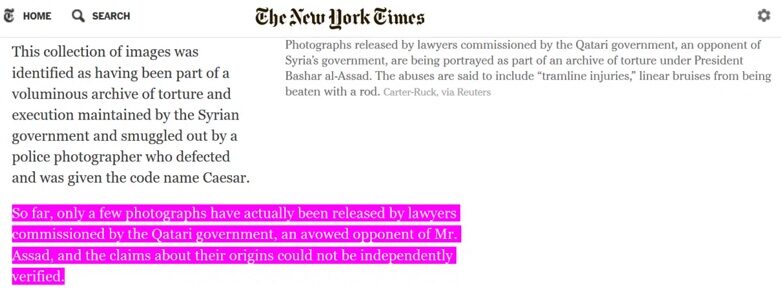
Nice, who had been charged with authenticating the photographic files, was listed at the time as "an advisor to Qatar in the possible Syria case to come." Desmond De Silva, another British lawyer called in to authenticate the documents, was later described as part of a team of "high profile lawyers instructed by the Qatari government."
The permanent monarchy of Qatar has bankrolled an array of Islamist militias across Syria over the years, including Al Qaeda's ruthless affiliate Jabhat al-Nusra. Carter-Ruck, the law firm employing Nice and De Silva under a Qatari contract, had also been hired by Turkish President Recep Tayyip Erdogan, another key sponsor of Syria's insurgency and the destabilization campaign against Damascus.
Also quoted on the significance of the Caesar file in the New York Times article was David Crane, who was merely described by the newspaper as "an investigator involved in examining the photos, who previously indicted President Charles G. Taylor of Liberia."
In fact, Crane was a veteran military-intelligence operative who previously held various positions inside the Pentagon, including at the Defense Intelligence Agency. Months before the Caesar file surfaced, he appeared on Capitol Hill to advocate for prosecuting Syrian government officials.
Crane stated in a 2014 interview that when his team began its investigation into the file,
"We brought in what we named 'Caesar,' the individual who brought out these photographs, along with handler - his case officer - interviewing them separately."His case officer? Crane's casual use of a term almost uniquely associated with CIA activity offered a strong suggestion that the Agency had played a role in grooming the mystery man known as "Caesar."
The UK-based academic Tim Hayward outlined the US government's role in supporting Crane's various Syria regime change projects. Crane, Hayward wrote:
"also leads the Syrian Accountability Project (SAP), which he founded some time prior to Caesar's defection. SAP is said to be student-run and its clients include the Syrian National Council and US State Department. It also 'works very closely with' the Syria Justice and Accountability Centre, which in turn is a conduit of US funding to CIJA."Crane authored the initial Qatar-sponsored report on Caesar's trove, yet was merely described as "a war crimes prosecutor" in a Vanity Fair puff piece about the file.
"Caesar" goes to Capitol Hill
On April 13, 2014, an anonymous man completely cloaked in a blue Patagonia hooded jacket from Hudson Trail Outfitters, purporting to be "Caesar" and claiming to bear photographic evidence of "genocide," appeared before the House Foreign Affairs Committee. Audio and video recording of the testimony was strictly forbidden, supposedly to protect Caesar's safety.
Caesar's handlers spun an elaborate tale to neoconservative Daily Beast writer Tim Mak about the "counter-surveillance techniques" they employed to protect their star witnesses identity in the days and hours before the hearing.
Somehow, no one covering the appearance of "Caesar" stopped to consider that the Syrian military might have already known the identity of one of the most high-profile defectors to emerge from its ranks. Were they protecting him from the Syrian Mukhabarat (which has no presence in the United States) or from public scrutiny?
As the anti-war activist and writer Rick Sterling pointed out, "how many military photographers took photos at Tishreen and Military 601 Hospitals during those years and then disappeared? According to the [Qatari] Carter Ruck report, Caesar's family left Syria around the same time. Considering this, why is 'Caesar' keeping his identity secret from the Western audience? Why does 'Caesar' refuse to meet even with highly sympathetic journalists or researchers?"
When "Caesar" appeared before the House Foreign Affairs Committee on August 4, 2014, he was seated beside the man who had brought him to Washington. The handler was Mouaz Moustafa, a Syrian-American regime-change lobbyist who served as the director of the State Department-funded Syria Emergency Task Force.
A key figure pushing for more arms to extremist militias inside Syria, Moustafa fervently opposed the State Department's listing of Jabhat al-Nusra, the Syrian Al Qaeda affiliate, as a terrorist group. "It was a mistake," he said to Foreign Policy of Nusra's blacklisting.
A year prior, Moustafa escorted Arizona Sen. John McCain on a trip inside Syria to meet with members of the CIA-backed Free Syrian Army — including kidnappers of Shia pilgrims — during a failed stunt to stimulate US military intervention.

Next, Frederic Hof of the Atlantic Council's Saudi-funded Rafic Hariri Center demanded that Congress respond to Caesar's testimony by allocating more US tax dollars to purchase weapons for anti-Assad extremist militants in Syria.
The stage was set for Congress to sign off on crushing sanctions on Syria, in bipartisan fashion and with negligible opposition. But first, the regime-change lobby mobilized to build a public case for its agenda by cynically linking the crisis it had helped foment in Syria to the Jewish genocide that took place in mid-century Europe.
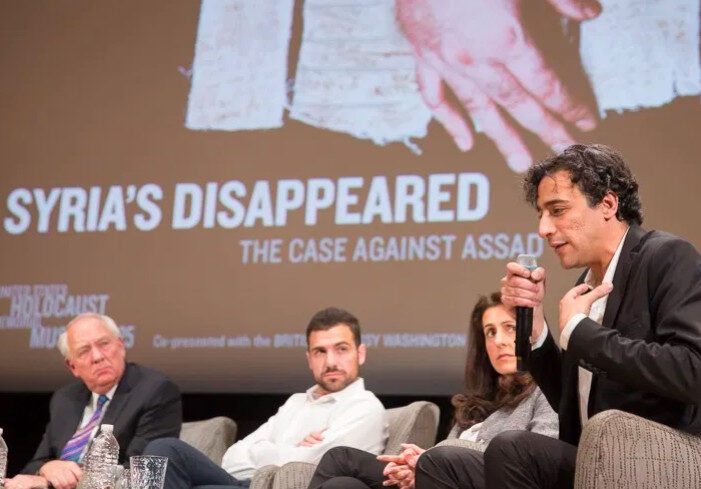
Back in July 2014, a self-styled human rights lawyer named Stephen Rapp sat on stage at the Saudi-funded Rafiq Hariri Center of DC's Atlantic Council think tank and demanded regime change in Syria: "Its legitimacy, its ability to serve the people of Syria is gone, if ever it where there," he said of Assad's government.
Throughout the event, entitled "Making the Case Against Assad," Rapp touted the work the aforementioned US-funded Center for International Justice and Accountability (CIJA) was doing to gather documents implicating the Syrian government, and the State Department's role in supporting them.
At the time, Rapp was the Barack Obama administration's ambassador-at-large for global criminal justice. He later moved on to serve as the chair of CIJA and visiting fellow at the US Holocaust Memorial Museum's Simon-Skjodt Center for the Prevention of Genocide, where according to his bio, he pursued "justice and accountability on Syria."
Rapp had worked with the Qatar-sponsored authors of the initial Caesar inquiry in the past when he, David Crane, and Desmond De Silva each served as chief prosecutor at the special court for Sierra Leone.
In his capacity at the Holocaust Museum, Rapp focused on "bringing forth the first case against the Assad regime and working on potential cases related to the 'Caesar file' in Germany."
Under Rapp's watch, the Holocaust Museum was transformed into an overt tool of US foreign policy in the Middle East. The institution's interventionist bent was supplemented by the presence of neoconservative ideologues like Iran-Contra felon Elliott Abrams, former DHS Chief Michael Chertoff, and Stuart A. Levey - a pioneer of US sanctions policy - on the museum's ironically named "Committee on Conscience."
In 2014, Mouaz Moustafa, the Syrian-American regime change lobbyist who worked as "Caesar's" handler, joined Stephen Rapp in helping the Holocaust Memorial Museum establish an exhibition likening the Syrian war to the Jewish genocide of World War Two Europe. The exhibit contained a special section on the Caesar file, presenting it as evidence of industrial mass murder without a scintilla of critical context or evidence.
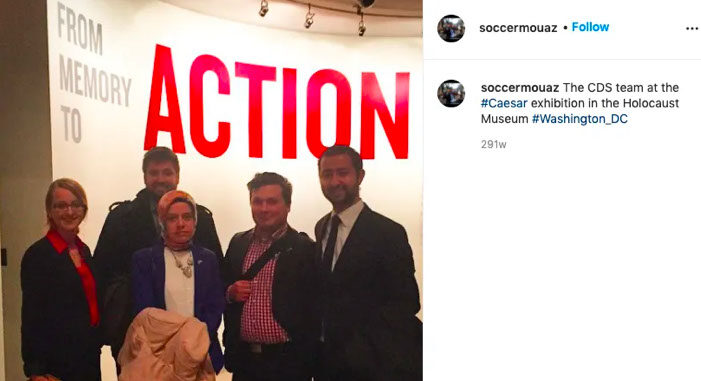
When the Holocaust museum in DC established its exhibition in late 2014, it was only able to display 10 carefully selected photos from the Caesar file. Once other investigators were able to view the full file, however, the one-sided narrative of its promoters began to crumble.
46% of the Caesar file reveals mass killings - by a brutal armed opposition
Though the full contents of the supposed Caesar file has never been made public, Human Rights Watch (HRW) was able to view the documents in full in 2015. In a lengthy report hyping the photos and attempting to reinforce the push for regime change, HRW inadvertently demolished Washington's narrative.
In a virtual footnote in its lengthy report on the Caesar file, HRW acknowledged that nearly half of the entire file - some 24,568 photos - depicted the bodies of government soldiers who had been killed by the armed opposition, "including [by] incidents of terrorism, fires, explosions and car bombs)."
As Rick Sterling noted:
"nearly half the [Caesar] photos show the opposite of what was alleged. These photos, never revealed to the public, confirm that the opposition is violent and has killed large numbers of Syrian security forces and civilians."HRW openly acknowledged its wholesale disinterest in this explosive fact, stating, "This report focuses on deaths in detention." However, the organization's researchers were unable to prove that the photos they were focused on showed the bodies of those who died in government prisons and not on the battlefield, or in other circumstances. In fact, it was able to verify only 27 cases in which individuals who appeared in the photos had been arrested.
The initial Qatar-sponsored Carter-Ruck investigation falsely claimed that the 11,000 individuals who appeared in the Caesar file had been killed in Syrian government custody. In an interview with France24, David Crane, the lead author of that report, noted that the bogus number was only a "statistical estimate."
HRW also revealed that though its researchers "sought an interview with Caesar through groups that identified themselves as representing him, the organization did not manage to meet with him."
Despite these disclosures, HRW's hyper-interventionist director Ken Roth continued to rattle off calls for US military intervention in Syria.
Others entities and individuals promoting the Caesar file, such as the New York Times and the directors of CIJA, similarly omitted HRW's stunning revelation that at least half the photos depicted government soldiers killed in the hands of foreign-backed opposition militias. In doing so, they preserved the Western narrative of the Syrian conflict as a one-sided, unprovoked slaughter carried out by President Assad against the whole of "the Syrian people."
As Caesar works Congress, sanctions begin killing the Syrian people
In November 2016, Congress expanded its sanctions on Syria while authorizing more funding for groups like CIJA focused on planning the prosecution of Assad and his officials. Co-sponsored by Rep. Eliot Engel, the aggressively pro-war, AIPAC-backed Democrat serving at the time as ranking chair of the House Foreign Affairs Committee, the bill was called the Caesar Civilian Protection Act.
"Caesar" was shepherded by his handler, Mouaz Moustafa, to meet personally with Engel and his Republican counterpart on the Foreign Affairs Committee, Rep. Ed Royce, in July 2018. As usual, the mysterious figure was shrouded in his blue Patagonia hooded jacket.
The meeting in Washington coincided with several new rounds of unilateral sanctions on Syria, meting out unprecedented economic punishment on the country's civilian population.
Nabih Boulos of the LA Times documented how the US and EU economic war against Syria had been especially harsh on the medical sector, making radiology equipment, chemotherapy drugs, and even basic pharmaceuticals increasingly difficult to obtain. One doctor told Boulos that 10 percent of his kidney patients had died due to faulty or inaccessible dialysis machines.
Sanctions also spurred a fuel crisis that made heating oil difficult to obtain during the winter of 2018, and brought ground traffic in several cities to a near-hault by the following Spring.
Rebuilding the war-torn country had also been slowed by the impact of the coercive measures, as the Caesar Act explicitly imposed costs on companies that participated in reconstruction, even threatening to punish Gulf states which dare to normalize relations with Damascus.
Congress signs off on Syrian misery, plunging the country's currency
On March 11, 2020, the usual suspects of the Caesar production assembled on Capitol Hill for one final lobbying push. This time, the full-time regime-change lobbyist Mouaz Moustafa delivered a self-described former prisoner from Syria's Saydnaya complex named Omar Alshogre to the House Foreign Affairs Committee to make the case for escalating the economic war.
Alshogre's dramatic performance demonstrated his background as a business consultant at the Boston Consulting Group and a motivational speaker managed by an elite speaker's bureau to secure Ted X lecture gigs. (Back in March 2019, Alshogre was brought onto CNN to attack Rep. Tulsi Gabbard, the maverick Democratic presidential candidate who had made opposition to regime-change wars a centerpiece of her campaign.)
Finally, this June, Congress passed the most crushing round of sanctions on Syria in history, imposing penalties on anyone conducting sovereign economic relations with any entity overseen by the Syrian government. "Anyone doing business with the Assad regime, no matter where in the world they are, is potentially exposed to travel restrictions and financial sanctions," said Secretary of State Mike Pompeo.
As the Caesar sanctions began to sink their teeth into the Syrian economy, the Financial Times acknowledged in a June 24 report,
"The first and biggest act of the Caesar act was felt, not by regime insiders, but by ordinary Syrians, who saw prices spike as the threat of sanctions roiled the country's currency market."A civilian population that has suffered through nearly a decade of war is being denied a peacetime recovery. For them, it marks another chapter in a tragic conflict imposed by outside powers.
But for the operatives behind the Caesar deception, the economic pain felt by average Syrians provides another regime-change "opportunity."
About the Author:
Max Blumenthal is an award-winning journalist and the author of several books, including best-selling Republican Gomorrah, Goliath, The Fifty One Day War, and The Management of Savagery. He has produced print articles for an array of publications, many video reports, and several documentaries, including Killing Gaza. Blumenthal founded The Grayzone in 2015 to shine a journalistic light on America's state of perpetual war and its dangerous domestic repercussions.
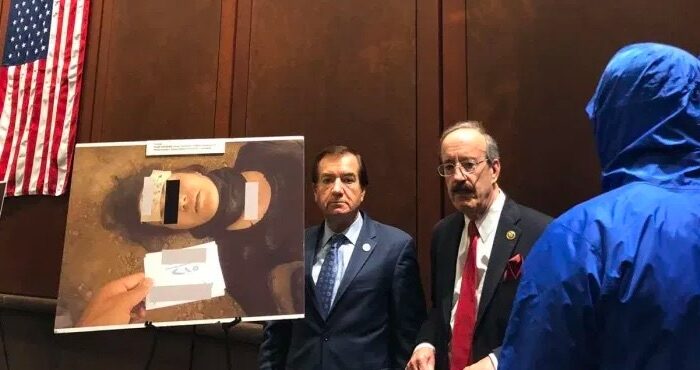
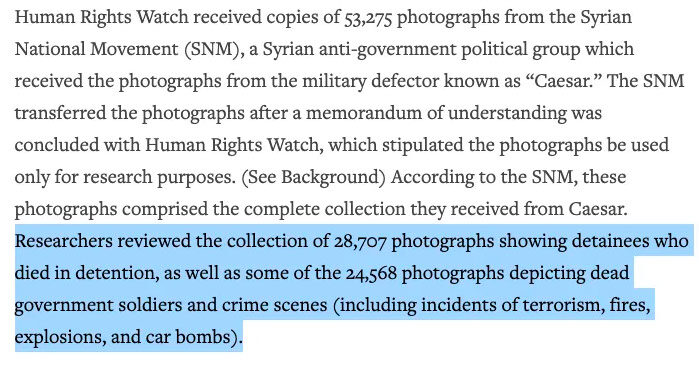



Reader Comments